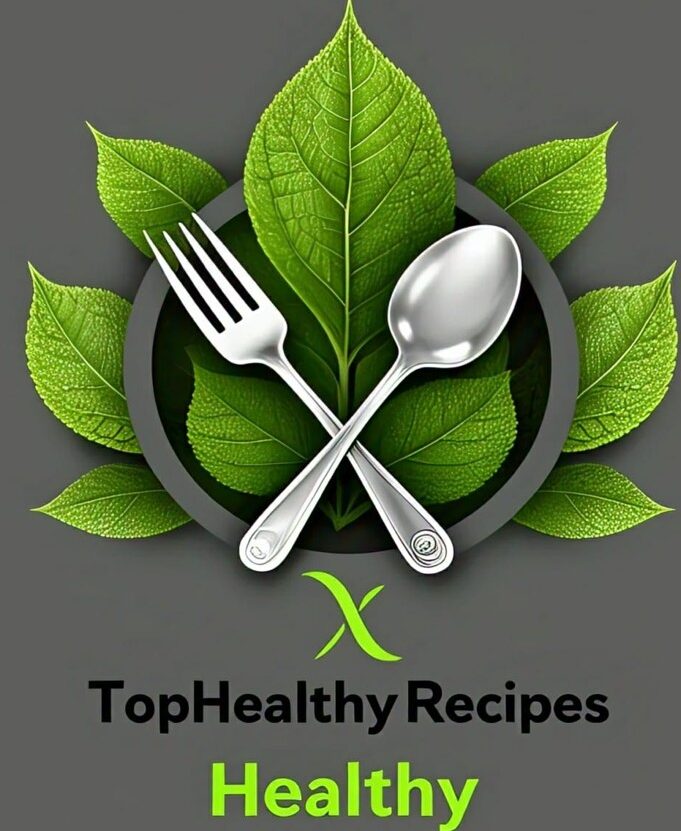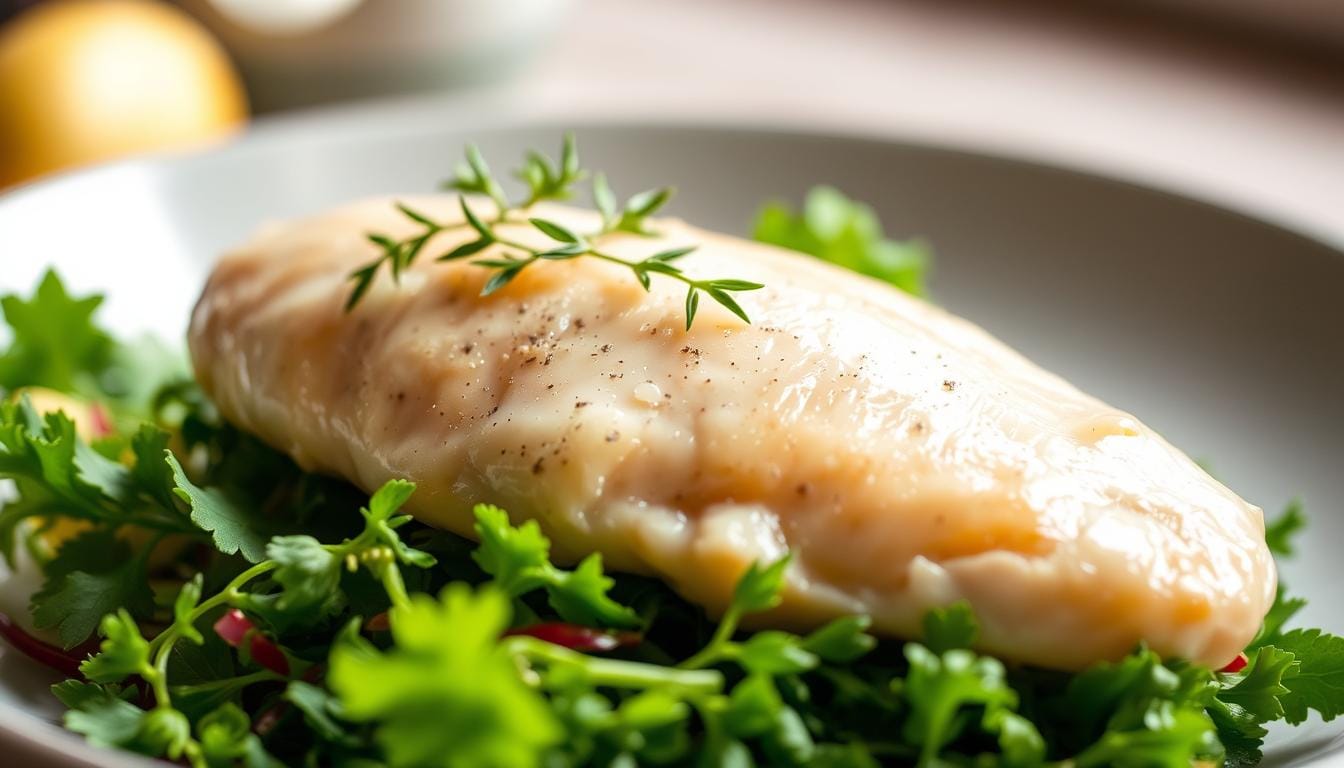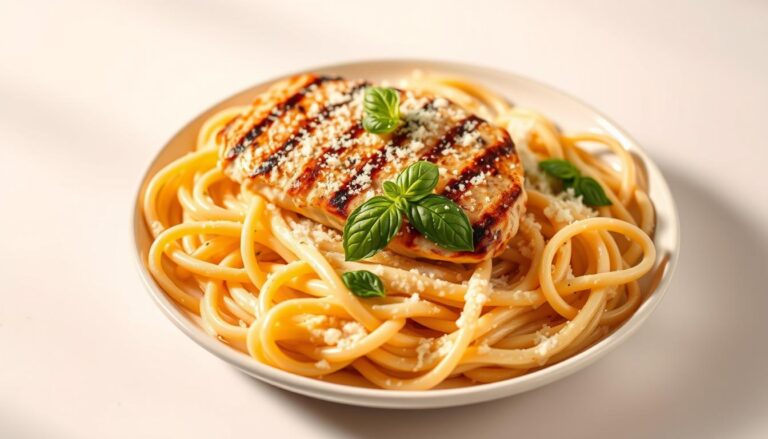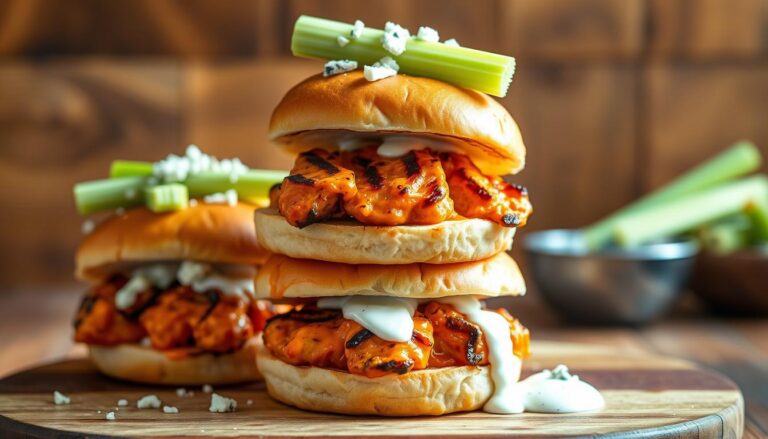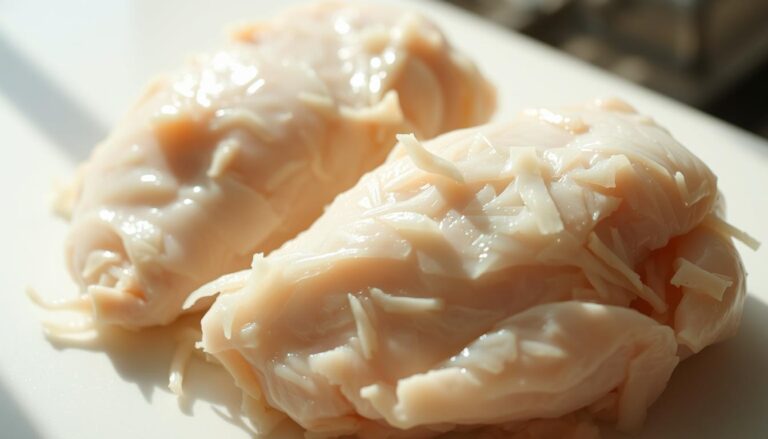Poached Chicken Breast Recipe: Simple and Delicious
Table of Contents
Poached Chicken Breast Recipe: Simple and Delicious
Looking for a quick, healthy, and juicy protein option? This method delivers tender, flavorful results in just 30 minutes. Perfect for meal prep, salads, or soups, it’s a versatile staple you’ll use again and again.
Unlike grilling or roasting, this technique locks in moisture while keeping things simple. With minimal ingredients and professional chef-approved steps, you’ll avoid dryness—a common issue with other cooking methods.
The secret? A cold-start approach and precise temperature control. Infuse extra flavor with herbs or broth, then enjoy it in grain bowls, wraps, or as a standalone dish.
Key Takeaways
- Ready in 30 minutes with basic ingredients
- Retains more moisture than grilled or roasted options
- Ideal for meal prep and multiple dishes
- Uses a cold-start technique for even cooking
- Easy to customize with herbs or broth
Why Poaching Is the Secret to Juicy Chicken Breasts
Want tender, juicy meat without the hassle? Poaching uses gentle heat to preserve moisture better than grilling or roasting. The method keeps temperature low, preventing proteins from tightening too quickly.
The Science Behind Gentle Cooking
Proteins denature at 150–160°F, a range perfect for poaching. Unlike boiling (212°F), this slow process lets collagen turn to gelatin, enhancing texture. Serious Eats’ tests show 30% more moisture retention versus dry-heat methods.
USDA guidelines recommend poultry reach 165°F internally. Starting with cold water ensures even cooking without overcooking the exterior.
Advantages Over Grilling or Roasting
Dry-heat methods cause rapid moisture loss. Poaching in broth or herbs infuses flavor while keeping meat succulent. The absence of the Maillard reaction (which creates crusts) means a delicate, uniform texture.
Energy transfers slower in liquid, so the center cooks evenly. Just simmer—don’t boil—to avoid toughness.
Poached Chicken Breast Recipe: Foolproof Method
Mastering this technique ensures perfectly cooked protein every time. With minimal effort, you’ll achieve tender results ideal for salads, wraps, or standalone dishes.
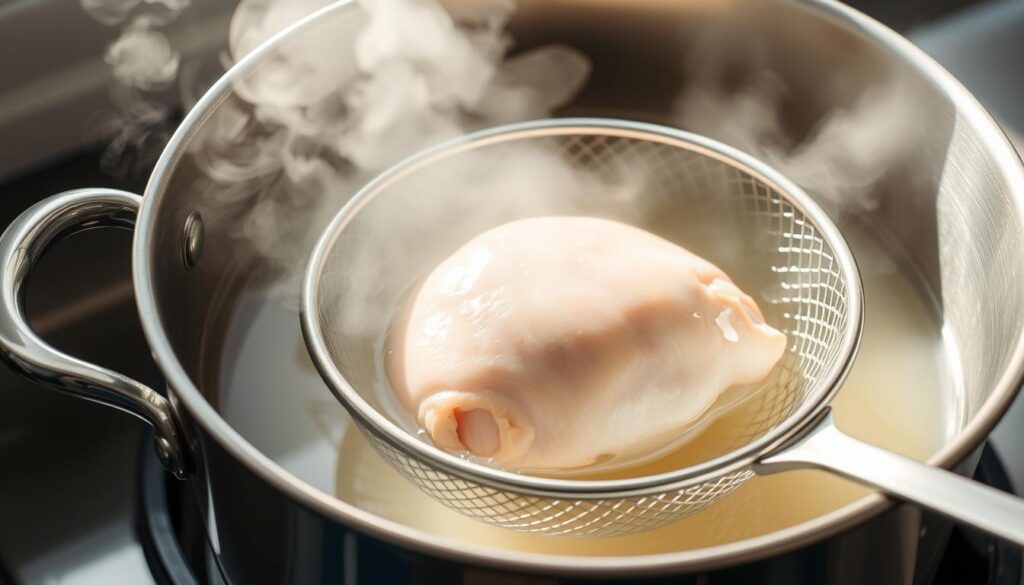
Essential Ingredients
Gather these basics:
- 4 cups water (or broth for extra flavor)
- 3 Tbsp Diamond Crystal salt (adjust for smaller batches)
- 1 lb protein (about 2 pieces)
- Optional: garlic, bay leaves, peppercorns
Step-by-Step Poaching Instructions
Use a heavy-bottomed pot to distribute heat evenly. Add cold water and salt, then submerge the protein fully—1″ coverage is key.
Heat on medium-low until it reaches a *simmer* (170–180°F). Never let it boil—this keeps texture delicate. Cook for 12–15 minutes.
How to Check Doneness
Insert an instant-read thermometer into the thickest part. Target 150°F; carryover cooking will raise it to 165°F during resting.
No thermometer? Pierce with a fork—juices should run clear, and meat should feel firm yet springy.
Building Flavor: Aromatics and Poaching Liquids
Transform plain protein into a flavor-packed dish with the right aromatics. Your poaching liquid acts as a canvas—infuse it with herbs, spices, or liquids to match any cuisine.
Best Herbs and Spices for the Liquid
Create global profiles with these combos:
- French: Thyme, bay leaves, and black peppercorns
- Asian: Ginger, scallions, and star anise
- Mediterranean: Garlic, lemon zest, and rosemary
Bundle spices in a cheesecloth sachet for easy removal. Overpowering flavors? Use half the amount—delicate proteins absorb seasonings quickly.
“Aromatic poaching doubles as a quick stock—simmer bones or veggie scraps in the used liquid for soups.”
Broth vs. Water vs. Wine: Pros and Cons
Choose your base wisely:
- Broth/stock: Adds depth but watch sodium levels—homemade cuts salt by 40%.
- Water: Neutral; ideal for heavily spiced dishes. Add 1 Tbsp salt per quart.
- Wine/cider: Alcohol evaporates, leaving subtle sweetness. Avoid cheap brands—acidity can toughen meat.
Save leftover poaching liquid—freeze it for future grains or sauces.
Pro Tips for Perfect Poached Chicken Every Time
Small adjustments make a big difference in mastering this cooking method. Whether you’re a beginner or a seasoned cook, these expert-backed strategies ensure juicy, flavorful results.

The Cold-Start Advantage
Starting with cold water guarantees even cooking. Proteins tighten gradually, preventing a tough exterior. This method aligns with USDA guidelines for safe internal temperatures.
Skip the boiling water plunge. A gentle *heat* rise (170–180°F) preserves moisture. For thicker cuts, extend the *time* to 45 minutes—but 30 usually suffices.
Salt Ratios and Seasoning Secrets
Use 1.5 tsp salt per pound for osmotic equilibrium. Dissolve it fully in cold water before adding protein. This brining step enhances flavor and texture.
For deeper seasoning, add aromatics to the liquid. Bundle herbs in cheesecloth for easy removal. Remember: underseasoned liquid = bland results.
Avoiding Common Mistakes
Myth: Clear juices mean done. Truth: Only a thermometer confirms 165°F. Peeking? Every lifted lid drops the *heat*, extending cook time.
Pound uneven cuts to uniform thickness. Overcooked? Shred it for tacos or salads. Food safety note: Never hold below 140°F for over two hours.
Creative Ways to Use Poached Chicken
Turn simple ingredients into restaurant-worthy meals with these creative ideas. Whether you’re meal prepping or improvising dinner, this protein adapts to any cuisine or craving.
Meal Prep Made Easy
Build a weekly plan with these fast options:
- Buffalo bowls: Shredded meat, quinoa, and hot sauce—ready in 10 minutes.
- Curried chicken salad: Greek yogurt, apples, and curry powder for a twist.
- Soup boost: Add cubed pieces to miso or vegetable broth.
Store portions in an airtight container for up to 2 days. Freeze extras for quick tacos or fried rice later.
Perfect Pairings: Grains and Sauces
Match textures and flavors with these combos:
| Grain | Sauce | Prep Time |
|---|---|---|
| Jasmine rice | Peanut satay | 15 mins |
| Farro | Lemon-caper | 20 mins |
| Cauliflower rice | Pesto | 10 mins |
“Repurpose poaching liquid into a base for risotto or quinoa—it’s packed with flavor.”
For crunch, top dishes with radishes or almonds. Shred for tacos; cube for salads. Two recipes, endless variations.
Storing and Reheating for Best Results
Keep your cooked protein fresh and flavorful with these storage tricks. Whether refrigerating for quick meals or freezing for future use, the right methods lock in texture and taste.
Refrigeration vs. Freezing
For short-term storage, use an airtight container and refrigerate for up to 4 days. Submerge pieces in broth to prevent drying out—this adds moisture during reheating.
Freezing extends shelf life to 3 months. Try these pro techniques:
- Vacuum sealing outperforms plastic wrap, reducing freezer burn by 70%.
- Ice-glazing: Dip portions in cold water, freeze, then repeat for a protective layer.
- Leave 1 inch between items for even freezing.
How to Keep Chicken Moist
Reheat gently to preserve tenderness. Microwave at 50% power in 30-second intervals, covering with a damp paper towel. For stovetop revival, simmer in broth or sauce for 5 minutes.
Dry leftovers? Steam them for 2 minutes or shred into soups or tacos. Always thaw frozen portions overnight in the fridge—never at room temperature.
Conclusion: Your Go-To Poached Chicken Mastery
Now you have all the tools to make tender chicken effortlessly. This method delivers juicy results every time, whether for meal prep or quick dinners.
Experiment with herbs, broths, or spices to match your taste. Always check temperatures with a thermometer for safety. Share your creations online—tag #PerfectPoached for inspiration!
Download our free temperature guide for foolproof cooking. Craving more ideas? Explore our collection of healthy recipes using this versatile technique.
Chefs worldwide swear by this simple approach. Once mastered, it becomes a kitchen staple for flavorful, moist results without the fuss.
FAQ
Why is poaching better than grilling for chicken?
What are the best herbs for the poaching liquid?
How do I know when the chicken is fully cooked?
Can I use water instead of broth?
How long can I store poached chicken in the fridge?
What’s the secret to reheating without drying it out?
For more cooking tips, stay connected with us. We also recommend the cookbook Skinnytaste Simple: Easy, Healthy Recipes with 7 Ingredients or Fewer
For more Recipes about Chicken
